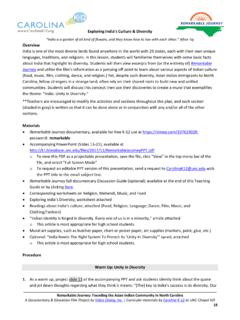Transcription of Tensors for Beginners
1 Tensors for BeginnersAlbert TarantolaSeptember 15, 20041 Tensor NotationsThe velocity of the wind at the top of Eiffel s tower, at a given moment, can be representedby avectorvwith components, in some local, given, basis,{vi}(i=1, 2, 3). The velocityof the wind is defined at any pointxof the atmosphere at any timet: we have avector fieldvi(x,t).The water s temperature at some point in the ocean, at a given moment, can be repre-sented by ascalar T. The fieldT(x,t)is ascalar state of stress at a given point of the Earth s crust, at a given moment, is representedby asecond order tensor with components{ ij}(i=1, 2, 3;j=1, 2, 3). In a generalmodel of continuous media, where it is not assumed that the stress tensor is symmetric, thismeans that we need 9 scalar quantities to characterize the state of stress. In more particularmodels, the stress tensor is symmetric, ij= ji, and only six scalar quantities are stress field ij(x,t)is asecond order tensor fields can be combined, to give other fields.
2 For instance, ifniis a unit vectorconsidered at a point inside a medium, the vector i(x,t)=3 j=1 ij(x,t)nj(x)= ij(x,t)nj(x)(1)represents the traction that the medium at one side of the surface defined by the normalniexerts the medium at the other side, at the considered a further example, if the deformations of an elastic solid are small enough, the stresstensor is related linearly to the strain tensor (Hooke s law). A linear relation between twosecond order Tensors means that each component of one tensor can be computed as a linearcombination of all the components of the other tensor: ij(x,t)=3 k=13 `=1cijk`(x) k`(x,t)=cijk`(x) k`(x,t).(2)Thefourth order tensor cijklrepresents a property of an elastic medium: its elastic each index takes 3 values, there are 3 3 3 3=81 scalars to define the elasticstiffness of a solid at a point (assuming some symmetries we may reduce this number to 21,and asuming isotropy of the medium, to 2).
3 1We are not yet interested in the physical meaning of the equations above, but in theirstructure. First, tensor notations are such that they are independent on the coordinates be-ing used. This is not obvious, as changing the coordinates implies changing the local basiswhere the components of vectors and Tensors are expressed. That the two equalities equal-ities above hold for any coordinate system, means that all the components of all tensorswill change if we change the coordinate system being used (for instance, from Cartesian tospherical coordinates), but still the two sides of the expression will take equal mechanics of the notation, once understood, are such that it is only possible to writeexpressions that make sense (see a list of rules at the end of this section).For reasons about to be discussed, indices may come in upper or lower positions, like invi,fiorTij. The definitions will be such that in all tensor expression ( , in all expressionsthat will be valid for all coordinate systems), the sums over indices will always concern anindex in lower position an one index on upper position.
4 For instance, we may encounterexpressions like =3 i=1 AiBi=AiBi(3)orAi=3 j=13 k=1 DijkEjk=DijkEjk.(4)These two equations (as equations 1 and 2) have been written in two versions, one withthe sums over the indices explicitly indicated, and another where this sum is implicitly as-sumed. This implicit notation is useful as one easily forgets that one is dealing with sums,and that it happens that, with respect to the usual tensor operations (sum with another ten-sor field, multiplication with another tensor field, and derivation), a sum of such terms ishandled as one single term of the sum could be an expression likeAi=DijkEjkit is said that the indicesjandkhave beencontracted(or are dummy indices ), while the indexiis afree index. A tensor equation is assumed tohold for all possible values of the free some spaces, like our physical 3-D space, it is posible to define the distance betweentwo points, and in such a way that, in a local system of coordinates, approximately Carte-sian, the distance has approximately the Euclidean form (square root of a sum of squares).
5 These spaces are calledmetric spaces. A mathematically convenient manner to introduce ametric is by defining the length of an arc byS= ds, where, for instance, in Carte-sian coordinates,ds2=dx2+dy2+dz2or, in spherical coordinates,ds2=dr2+r2d 2+r2sin2 d 2. In general, we writeds2=gijdxidxj, and we callgij(x)themetric fieldor,simply, components of a vectorvare associated to a given basis (the vector will havedifferent components on different basis). If a basiseiis given, then, the componentsviaredefined throughv=viei(implicit sum). Thedual basisof the basis{ei}is denoted{ei}and is defined by the equationeiej= ij(equal to 1 ifiare the same index and to 0 ifnot). When there is a metric, this equation can be interpreted as a scalar vector product, andthe dual basis is just another basis (identical to the first one when working with Cartesiancoordinates in Euclidena spaces, but different in general). The properties of the dual basiswill be analyzed later in the chapter.
6 Here we just need to recall that ifviare the components2of the vectorvon the basis{ei}(remember the expressionv=viei), we will denote byviare the components of the vectorvon the basis{ei}:v=viei. In that case (metricspaces) the components on the two basis are related byvi=gijvi: It is said that the metrictensor ascends (or descends) the indices .Here is a list with some rules helping to recognize tensor equations: A tensor expression must have the samefreeindices, at the top and at the bottom, ofthe two sides of an equality. For instance, the expressions =AiBi =gijBiCjAi=DijkEjkDijk= iFjk(5)are valid, but the expressionsAi=FijBiBi=AjCjAi=Bi(6)are not. Sum and multiplication of Tensors (with eventual contraction of indices) gives ten-sors. For instance, ifDijk,GijkandHijare Tensors , thenJijk=Dijk+GijkKijk`m=DijkH`mLik`=Dij kH`j(7)also are Tensors . True (or covariant ) derivatives of tensor felds give tensor fields. For instance, ifEijis a tensor field, thenMijk= iEjkBj= iEij(8)also are tensor fields.
7 But partial derivatives of Tensors do not define, in general, ten-sors. For instance, ifEijis a tensor field, thenMijk= iVjkBj= iVij(9)are not Tensors , in All objects with indices that are normally introduced are Tensors , with four notableexceptions. The first exception are the coordinates{xi}(to see that it makes no senseto add coordinates, think, for instance, in adding the spherical coordinates of twopoints). But the differentialsdxiappearing in an expression likeds2=gijdxidxjdo correspond to the components on a vectordr=dxiei. Another notable exceptionis the symbol imentioned above. The third exception is the connection ijktobe introduced later in the chapter. In fact, it is because both of the symbols iand ijkare not Tensors than an expression like iVj= iVj+ ikjVk(10)can have a tensorial sense: if one of the terms at right was a tensor and not the other,their sum could never give a tensor. The objects iand ijkare both non Tensors , and what one term misses, the other term has.
8 The fourth and last case of objects withindices which are not Tensors are the Jacobian matrices arising in coordinate changesx y,JiI= xi yJ.(11)That this is not a tensor is obvious when considering that, contrarily to a tensor, theJacobian matrix is not defined per se, but it is only defined when two different coordi-nate systems have been chosen. A tensor exists even if no coordinate system at all hasbeen Differentiable ManifoldsA manifold is a continuous space of points. In ann-dimensional manifold it is always possi-ble to draw coordinate linesin such a way that to any pointPof the manifold correspondcoordinates{x1,x2, .. ,xn}and vice that the manifold is a continuous space of points is equivalent to say that thecoordinates themselves are continuous , , if they are, in fact, a part ofRn. On suchmanifolds we define physical fields, and the continuity of the manifold will allow to definethe derivatives of the considered fields.
9 When derivatives of fields on a manifold can bedefined, the manifold is then called adifferentiable examples of differentiable manifolds are the lines and surfaces of ordinary ge-ometry. Our 3-D physical space (with, possibly, curvature and torsion) is also representedby a differentiable manifold. The space-time of general relativity is a four dimensional dif-ferentiable coordinate system may not cover all the manifold. For instance, the poles of a sphereare as ordinary as any other point in the sphere, but the coordinates are singular there (thecoordinate is not defined). Changing the coordinate system around the poles will makeany problem related to the coordinate choice to vanish there. A more serious difficultyappears when at some point, not the coordinates, but the manifold itself is singular (thelinear tangent space is not defined at this point), as for instance, in the example shown infigure 1. Those ane named essential singularities.
10 No effort will be made on this book toclassify 1: The surface at left has an essentialsingularity that will cause trouble for what-ever system of coordinates we may choose(the tangent linear space is not defined atthe singular point). The sphere at rigth hasno essential singularity, but the coordinatesystem chosen is singular at the two coordinate systems will be singular atdifferent Tangent Linear Space, , for instance, in classical dynamics, a trajectoryxi(t)on a space which may notbe flat, as the surface of a sphere. The trajectory is on the sphere. If we define now thevelocity at some point,vi=dxidt,(12)we get a vector which is not on the sphere, buttangentto it. It belongs to what is called thetangent linear spaceto the considered point. At that point, we will have a basis for another point, we will another tangent linear space, and another vector generally, at every point of a differential manifold, we can consider different vectoror tensor quantities, like theforces,velocities, orstressesof mechanics of continuous media.


